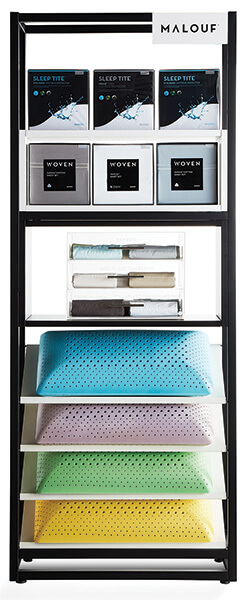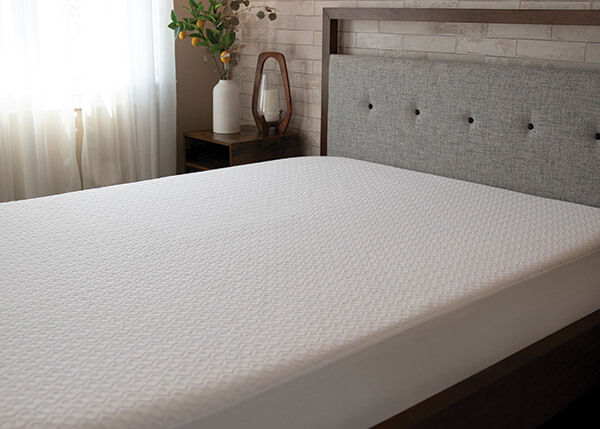Bedding retailers can boost sales of protectors, toppers and linens by committing to the category and making it easy for consumers to buy from them
A new survey from the Better Sleep Council shows that buying a mattress most often prompts consumers to shop for the sleep accessories that help turn the bed set into a sleep ensemble.
Nine in 10 who purchased a mattress bought sheets and nearly as many bought pillows. Seven in 10 added a mattress pad or a protector, and six in 10 purchased a topper, according to the survey from the BSC, the consumer education arm of the International Sleep Products Association. (Read the full survey results on page 19.)
But a mattress purchase isn’t the only thing that prompts consumers to shop for accessories. Not unexpectedly, they also buy top-of-bed products when their own start to wear out — and also to upgrade to items made with better quality materials or those offering more benefits.
The why matters
One big survey takeaway: Bedding retailers can boost sales of accessories by appealing to consumers shopping for different reasons.
For consumers buying a mattress, a key is to talk early in the rest-testing process about creating a sleep ensemble that will enhance the features and benefits of their new bed.
Another natural time to bring up problem-solving accessories is when retail sales associates ask about sleep problems. (“Do you have allergies? A six-sided mattress
encasement and pillow encasements can help prevent allergen buildup from dust mites and pet dander.” “Do you sleep hot? These sheets wick away moisture and stay cool to the touch throughout the night.”)
“We recommend bringing up accessories early and often in the sales pitch. What are they looking for? Do they have any budgetary constraints? Do they sleep hot? Asking these questions early on will allow RSAs to incorporate the right accessory mix in their sales pitch,” says Ashlee Willes, brand manager for Malouf, a Logan, Utah-based company that offers bedroom furniture, adjustable bases, pillows, toppers, sheets, blankets, protectors and other sleep accessories.
“Sooner is always better than later,” agrees Rick Sterzer, executive vice president of sales and marketing for Rize, a division of Mantua Manufacturing Co., headquartered near Cleveland, Ohio, that sells a full range of bedding products. “However, the most important thing is for the RSA to truly understand the consumer’s sleep needs, then work as a consultant to recommend the appropriate products, referring back to the consumer’s comments about their current sleep and sleep environment.”

For consumers already buying a mattress, another key is to remind them that purchasing everything at once, before they leave the store, will save them time and hassle later. The one-stop-shop idea also ensures they will get items that best work together for a great night’s sleep.
And to reach consumers who want to replace worn top-of-bed items or upgrade to better products, be sure to promote good-better-best lineups that make it easy for shoppers to understand the features of each level — and how they’ll benefit from choosing a better or best option.
Best practices
There is some distressing news in the survey results. Sleep Savvy believes strongly that consumers benefit from buying top-of-bed products from mattress specialists. But the BSC survey shows many consumers turn to other sources first, notably from big discount stores or online retailers.
But there are ways for bedding retailers to capture consumer attention and their dollars. Sleep accessories providers have more ideas for helping to boost sales of protectors, toppers and linens. (Sleep Savvy will look in-depth at pillows in our November/December issue.)
Show ’em if you’ve got ’em.
Commit to the top-of-bed category with attractive displays near the store entrance and near models where you start comfort tests and where you fit pillows. Don’t hide them on a back wall — unless you turn that back wall into a dramatic display.
“For in-store, it’s always important to find ways to cross-sell other bedding essentials in the same area of a store,” says Christopher Leary, director of marketing for Bedgear. The Farmingdale, New York-based company produces mattresses and adjustables bases, as well as pillows, sheets, protectors and blankets.
“For example, retailers can hang pillowcases or protector swatch samples alongside mattresses or in the mattress gallery for convenience, without having the shopper walk to the linens section of the store,” he says. “Additionally, in-store shoppers can actually feel and engage with the products all in one location and be reminded to complete their sleep system.”
Many sleep accessories companies provide displays designed to educate consumers and encourage them to feel and compare products. Malouf offers a modular rack for pillows, sheets, protectors or any combination of the three that “allows customers to touch and feel the fabrics you have on display,” Willes says.
“Research shows that about 70% of buying decisions are made in-store,” she says. “One of the simplest and most underutilized tools in helping customers make decisions and drive sales is the display.”
Bedgear offers interactive and engaging displays for retailers to create better in-store experiences, according to Leary.
“We work with our retail partners to create experiences that can be retail sales associate assisted or not. For instance, some retailers have consumers who want to be educated first before purchasing a product. As a result, Bedgear provides airflow machine carts, allowing shoppers to educate themselves on airflow by placing a Bedgear sheet or pillow on top of the cart and feel the amount of air that freely flows through it.”
Rize incorporates demos into its in-store displays, too.
“We offer a high-quality display rack that fits nicely in any mattress gallery or showroom along with liquid shaker and fabric demos to prove our value to the consumer and show other options like our Smooth or Quilted Tencel (protector) and our six-sided encasement,” Sterzer says. “These other options allow the RSA to step up or down the category as needed.”
Hone your online strategy.
Robust product listings are key for e-commerce conversion. We recommend high-quality images that catch the eye of online shoppers,” Willes says.

Leary advises retailers to “consider both the desktop and mobile shopping experiences” and to optimize both. “Many of today’s shoppers are quickly perusing through products and purchasing on their mobile phones. Are the differentiators of the product clearly explained, both in text and in easily absorbed visuals? Mobile shoppers are easily distracted so you need to have compelling differentiators that explain the ‘why’ behind the products in order for them to click the ‘Buy Now’ button.”
And as with ready-made in-store displays, retailers can make their lives easier by taking advantage of marketing work vendors have already done. “Malouf provides free marketing resources specifically for success online that can be accessed anytime by our retail partners,” Willes says. “We have an easy-to-use content sheet with listing copy and imagery that make uploading products to your website a breeze.”
Sell your expertise.
Both online and in-store, retailers should promote their accessories expertise and breadth of product. Incorporate regular top-of-bed promotions into your social media campaigns and traditional advertising efforts.
“Free-with-purchase” is a good way to devalue accessories. Instead, offer specially priced bundles that highlight the value of each accessory and help the consumer see the importance of pieces that work well together. Try bundling a protector and a sheet set, or an encasement with two pillows.

